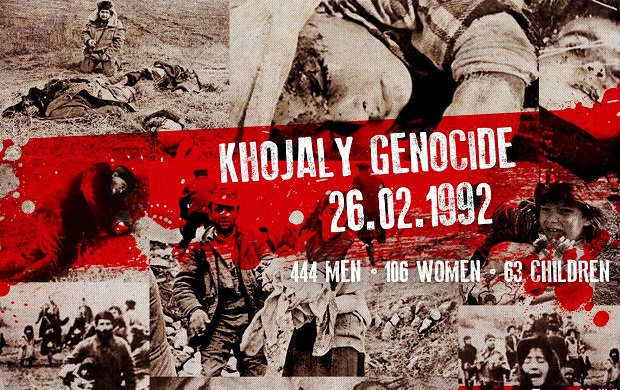
by Rafaqat Hussain, Research Associate, MUSLIM Institute
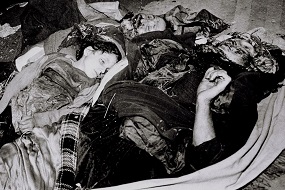 |
Khojaly massacre is among the most barbaric killing of masses in twentieth century. In Nagorno-Karabakh, the disputed territory between Azerbaijan and Armenia, Khojaly is located 10 km to southeast from Khankendi, capital city of the territory. On February 25-26, 1992, Armenian military forces committed genocide in the town of Khojaly, 613 people were killed and 1275 were taken hostage in Khojaly genocide. 106 women, 63 children, 70 old men were killed. 8 families were completely annihilated, 130 children lost one parents, while 25 both of them. The fate of 150 is still unknown. Armenians scalped, cut people's head and other organs off, eyes gouged out, while pregnant women were bayoneted in the abdomen. Above mentioned facts prove that Armenia committed genocide of civilians, violating Geneva Convention protocol concerning war rules. Russian 366th infantry guard regiment joined Armenians in perpetrating this tragedy. Along with Khojaly, Armenia occupied other Azerbaijani territories of the Nagorno-Karabakh region and seven adjacent districts. It conducted ethnic cleansing of the seized areas, expelling about one million Azerbaijanis from their native lands and committing other serious international crimes. Finally, it established a subordinate, ethnically homogenous separatist entity in the occupied Azerbaijani territory.
In Khojaly case, the existence of the genocidal intent can be inferred, inter alia, from the fact that special traps were prepared in advance and then used for shooting civil Azerbaijani Turks, who were trying to escape. The fact that those acts aimed at the Azeri national group was obvious.
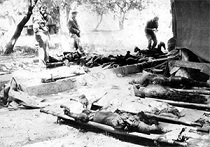 |
Famous expert Thomas de Waal, in his book "Black Garden", cites remarks by Serzh Sargsyan, the then "field commander" and now Armenian president, "Before Xocaly [Khojaly], the Azerbaijanis thought that they could joke with us, they thought that the Armenians were not capable of raising their hand at the civilian population. We managed to break this (stereotype). This is what happened."
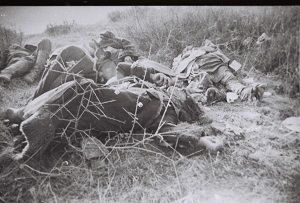 |
What was Armenians' purpose in Khojaly? On one hand that was the liquidation of the strategic hindrance in the form of Azerbaijani Turkish residents of the mountainous part of Nagorno-Karabakh. This Turkish population prevented the policy of Armenian ethnic cleansing against all Azerbaijanis over Nagorno-Karabakh, hence Armenians decided to annihilate Turkic origin people of Khojaly town. On the other hand, Khojaly was an inhabited place which has reflected the history and traditions of Azerbaijan dating back B.C. XIV-VII centuries. This distinct culture is classified as Khojaly-Gadabay in the Azerbaijani history. Cromlechs, dolmens, Cyclops, tumuli of Khojaly, as well as different housing wares are the patterns of material culture that reflect the dynamics of social development.
 |
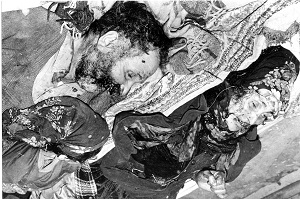 |
There are four resolutions, Resolution 822, 853, 874, 844 passed in the UN Security Council which endorses the stance of Azerbaijan. In Resolution 822 passed in 1993 United Nation accepted and endorsed the legitimate stance of Azerbaijan towards illegal occupation of Armenia on its territories. Resolution 853 in 1993 once again reaffirmed that the Nagoro-Karabagh is an inalienable part of Azerbaijan and demanded immediate, complete and unconditional withdrawal of the occupying forces from all occupied territories of Azerbaijan. It called for the withdrawal of Armenian troops from Kelbajar, Agdam, Fizuli, Jabrayil, Qubadli, and Zangilan. Similarly, there is a resolution in the General Assembly 62/243 passed in 2008, it condemned the use of force against Azerbaijan and occupation of its territories and reaffirmed the sovereignty and territorial integrity of Azerbaijan and the inviolability of its international recognized borders. Remembering such heinous crimes against humanity is essential to send a message to the perpetrators that in no way can a culture of impunity prevail and sooner rather than later justice will triumph. Furthermore, it contributes towards achieving peace and reconciliation and prevents repetition of such crimes.
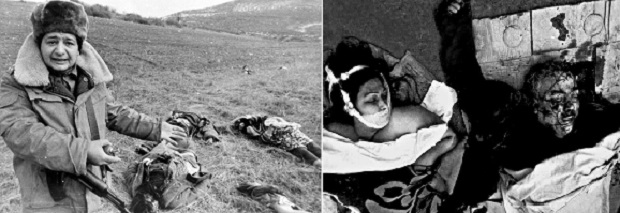 |
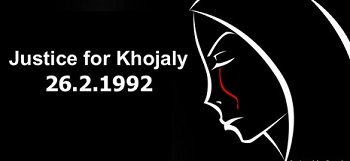 |
Download pdf Newsletter Share
